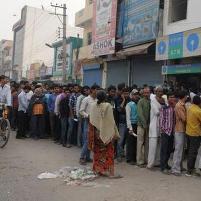  People have different views on the impact of demonetization of old 1000 and 500 rupee notes on the economy and the society. However, everyone except a few mandarins of North and South block agree that it is a poorly executed move. The problem is serious in rural areas where cash is a necessity in day to day life. In my home state of Uttarakhand, people have to travel 20 to 30 kms in hills to reach nearest banks. Most of the villages are inhibited by women and old people as young men are away in plains to earn livelihood. It is ridiculous to imagine that they are willingly fighting Modi’s war against black money. Most of them do not even understand what black money is.
It is clear that Modi has been let down by the Babus who failed to advice him about the impact of demonetization on honest citizens, especially in rural areas. The fact is that there is no basic infrastructure in large parts of rural areas where one can exchange notes, even if RBI manages to print sufficient new notes.
The problem could have been mitigated significantly if the NDA government was successful in implementing Digital India.
Under Digital India, the government is supposed to provide high speed broadband to all the village Panchayats. By March, 2017, the government had to connect 2.5 lakh villages with a country wide optical fibre cable (OFC). These Village Centres were supposed to provide various government-to-citizen services. This means that all the ministries would have done a lot of digitization of services such as pension scheme, DBT and would have linked it with Aadhaar.
The Village centres could have acted as Banking Correspondents. People could have easily exchanged notes and deposited cash in their villages.
The government was supposed to connect 100,000 Village Panchayats by March, 2016. However, only 8,000 Village Panchayats could be connected by March. By July end only 10,000 Village Panchayats could be connected.
It is time that Babus at Sanchar Bhawan introspect why Digital India has failed. If there were some problems related to policies, department of telecommunications (DoT) should formulate new policies.
Presently, Bharat Broadband Network Limited (BBNL), a PSU under DoT is responsible for implementing the project. It has selected various companied for procuring OFC and transmission equipment. These companies are supposed to lay the network and make it operational. It is clear that this model has failed.
When the present TRAI chairman R. S. Sharma was secretary of the department of electronics and Information technology, he pointed out in Telecom Commission meetings that EPC (Engineering, Procurement and Construction) model would not work. As Telecom Regulator, Sharma has recommended that the government should follow BOOT (Build, Own, Operate and Transfer) model to make BharatNet successful. An alumnus of IIT (Kanpur), Sharma understands technical side of implementation of such a large telecom project.
The government should act fast. It should try to infuse life into the Digital India project and implement it fast. |